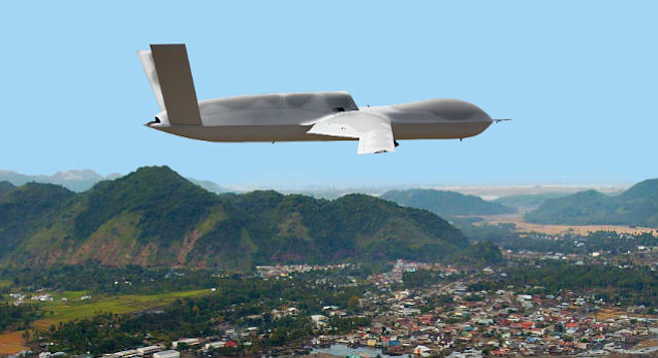 Facebook
Facebook
 X
X
 Instagram
Instagram
 TikTok
TikTok
 Youtube
Youtube

San Diego–based General Atomics, makers of the military's Predator and Reaper drones (“unmanned aerial vehicles,” as the industry prefers to call them), has landed a contract to begin experiments equipping the bombing and surveillance aircraft with laser weapons.
With $8.8 million from the federal Missile Defense Agency, the firm "will address laser power and aperture size by integrating and testing a low power laser on an unmanned aerial vehicle," likely by the year 2020.
According to a FlightGlobal report, the likeliest General Atomics drone to carry the laser weapon would be its Avenger or Angel One, both of which are capable of reaching 50,000 feet of altitude and flying for six hours or more, allowing the devices to be deployed in airspace where they could attack and shoot down ballistic missiles in flight. The company has sought to play down the focus on attack capabilities of their products, noting that the Angel One "could easily be used for the rapid delivery of humanitarian relief packages."
Though the contract would explore the possibility of launching a fleet of round-the-clock flying lasers ready to shoot down an enemy missile, the actual technology to do so is still in the early stages. The low-power lasers General Atomics' drones would carry will test the ability to target and focus a beam for a period of time at long range, but they won't generate enough energy to do serious damage.
For that capability, Lockheed Martin, which several years ago shuttered its San Diego operations, has been tapped by the Air Force Research Laboratory to develop weapons-grade lasers for installation in fighter jets. The project competes with another program already in the works at General Atomics that could be ready for testing as early as next year.


San Diego–based General Atomics, makers of the military's Predator and Reaper drones (“unmanned aerial vehicles,” as the industry prefers to call them), has landed a contract to begin experiments equipping the bombing and surveillance aircraft with laser weapons.
With $8.8 million from the federal Missile Defense Agency, the firm "will address laser power and aperture size by integrating and testing a low power laser on an unmanned aerial vehicle," likely by the year 2020.
According to a FlightGlobal report, the likeliest General Atomics drone to carry the laser weapon would be its Avenger or Angel One, both of which are capable of reaching 50,000 feet of altitude and flying for six hours or more, allowing the devices to be deployed in airspace where they could attack and shoot down ballistic missiles in flight. The company has sought to play down the focus on attack capabilities of their products, noting that the Angel One "could easily be used for the rapid delivery of humanitarian relief packages."
Though the contract would explore the possibility of launching a fleet of round-the-clock flying lasers ready to shoot down an enemy missile, the actual technology to do so is still in the early stages. The low-power lasers General Atomics' drones would carry will test the ability to target and focus a beam for a period of time at long range, but they won't generate enough energy to do serious damage.
For that capability, Lockheed Martin, which several years ago shuttered its San Diego operations, has been tapped by the Air Force Research Laboratory to develop weapons-grade lasers for installation in fighter jets. The project competes with another program already in the works at General Atomics that could be ready for testing as early as next year.
Comments